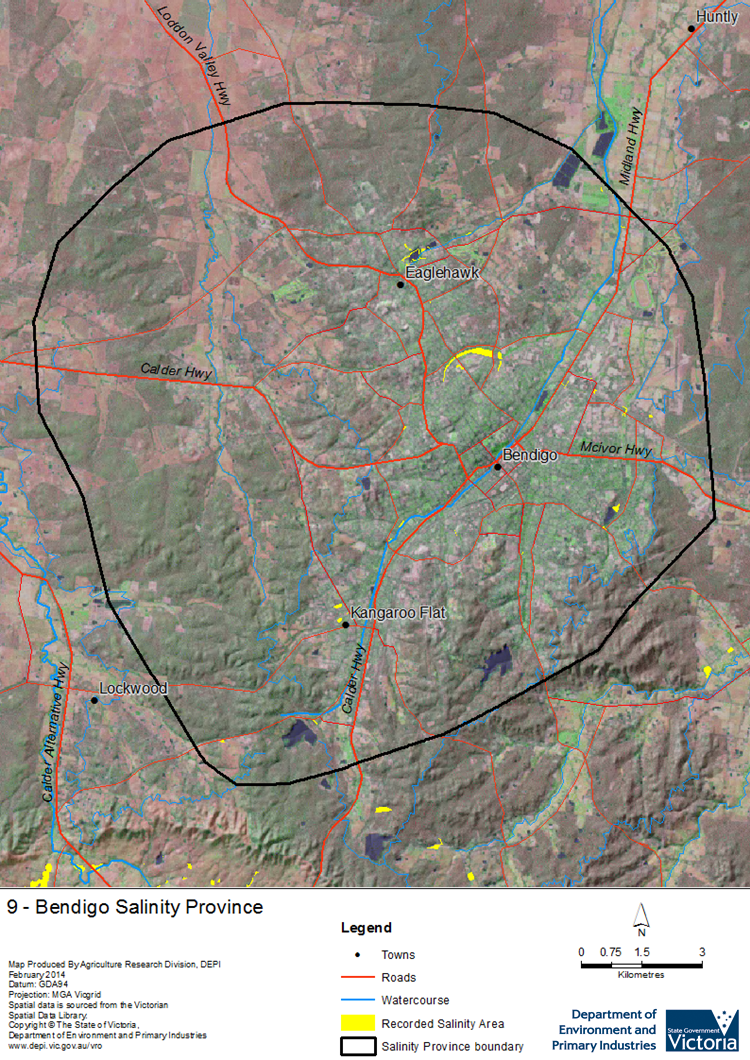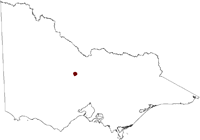Salinity Province 9, Bendigo
|
|
Province Attributes
| Catchment Management Region: | NORTH CENTRAL |
| Priority Status: | High |
| Province Area: | 21,690 ha |
| Recorded Soil Salinity Area 1: | 35 ha |
| Dominant Surface Geology Type: | Sedimentary |
| Influence of Geological Structure on Salinity Occurrence/s: | None |
| Relevant Geomorphological Mapping Units (GMUs): | 2.1.2 |
| Predominant Groundwater Flow Systems (GFSs): | Local/Intermediate |
| Relevant Irrigation Areas: | N/A |
Bendigo Salinity Province Map

Links to further reading and material related to the North Central Salinity Province
For further information relating to groundwater levels and salinities in this Province please see: Visualising Victoria's Groundwater (VVG)
1 Please Note: The ‘Recorded Soil Salinity Area’ indicated in the Salinity Province Attribute Table, comprises the total geographic area that has been mapped as having, or showing symptoms of, dryland soil salinity at some time (past or present). As dryland salinity occurrence in the Victorian landscape exhibits many different levels of severity and can change due to climate, landuse and vegetation, previously mapped areas may no longer be showing symptoms. In addition, as not all parts of the State have been mapped, or mapped in the same way, the mapping may not have captured some occurrences.
The soil salinity mapping used to calculate this ‘area’ does not cover irrigation regions. In irrigation regions, depth to watertable and watertable salinity mapping has been used to convey the threat of high watertables on soil waterlogging and/or soil salinisation and these areas are not included in this ‘area‘ calculation.
Please contact the Department, your Catchment Management Authority or your rural water provider for more information about salinity in your location.

 The small Bendigo Salinity Province in central Victoria is centred on the town of Bendigo. Local to intermediate scale Groundwater Flow Systems in weathered fractured Palaeozoic rocks drive saline discharge along drainage lines, with overlying minor alluvial material restricting subsurface drainage. Alluvial gold mining activity has altered groundwater flow and mobilised inherently saline soils. Salinity is often associated with tailing dumps and worked valley floors. Significant impact to building and urban infrastructure has been recorded and saline/mine runoff remains an issue into Bendigo Creek. Urban runoff, garden watering and water storage facilities contribute to higher groundwater recharge driving saline groundwater to adjacent creeks. Although the total area of salt affected land is relatively small, the impact to high value assets (housing and infrastructure) is significant.
The small Bendigo Salinity Province in central Victoria is centred on the town of Bendigo. Local to intermediate scale Groundwater Flow Systems in weathered fractured Palaeozoic rocks drive saline discharge along drainage lines, with overlying minor alluvial material restricting subsurface drainage. Alluvial gold mining activity has altered groundwater flow and mobilised inherently saline soils. Salinity is often associated with tailing dumps and worked valley floors. Significant impact to building and urban infrastructure has been recorded and saline/mine runoff remains an issue into Bendigo Creek. Urban runoff, garden watering and water storage facilities contribute to higher groundwater recharge driving saline groundwater to adjacent creeks. Although the total area of salt affected land is relatively small, the impact to high value assets (housing and infrastructure) is significant.
